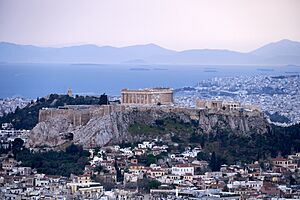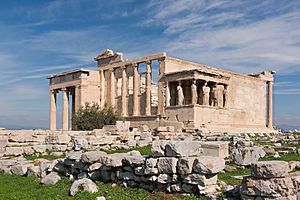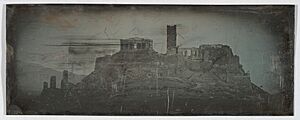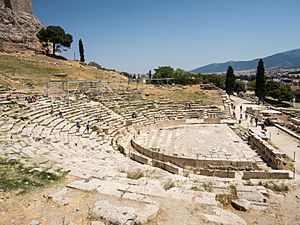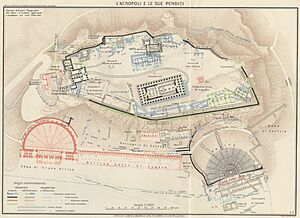Acropolis of Athens facts for kids
| UNESCO World Heritage Site | |
|---|---|
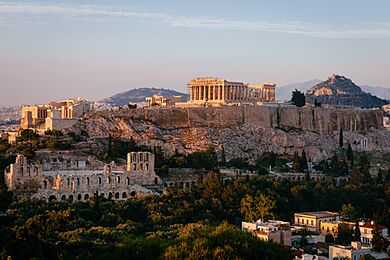
The Acropolis of Athens, seen from Philopappos Hill
|
|
| Location | Athens, Attica, Greece |
| Criteria | Cultural: i, ii, iii, iv, vi |
| Inscription | 1987 (11th Session) |
| Area | 3.04 ha |
| Buffer zone | 116.71 ha |
The Acropolis of Athens is an ancient fortress built on a rocky hill above the city of Athens, Greece. It holds the remains of many important old buildings. The most famous one is the Parthenon. The word "Acropolis" means "highest point of the city" in Greek. In ancient times, it was also called Cecropia, named after a legendary king of Athens, Cecrops.
People lived on this hill as early as 4000 BC. But it was Pericles, a famous leader in the 5th century BC, who planned the amazing buildings we see today. These include the Parthenon, the Propylaea, the Erechtheion, and the Temple of Athena Nike. Sadly, these buildings were badly damaged in 1687. During a war, gunpowder stored in the Parthenon exploded after being hit by a cannonball.
Contents
A Look Back: The Acropolis Through Time
The Acropolis sits on a flat-topped rock about 150 meters (492 feet) above sea level. Its top covers about 3 hectares (7.4 acres). People have lived in this area since about 6000 BC.
Early Days: A Mycenaean Palace
Long ago, during the Bronze Age, a large palace likely stood on the Acropolis hill. We don't have much left of it, just a few stone pieces. Later, a huge wall was built around the hill. This wall was 760 meters (2,493 feet) long and up to 10 meters (33 feet) high. It was the main defense for the Acropolis until the 5th century BC. This strong wall helped protect the people inside. There was also a secret well for drinking water during attacks.
Ancient Temples: The Archaic Acropolis
We don't know much about the Acropolis's look until the Archaic period (around 700-500 BC). During this time, leaders like Peisistratos built an entry gate. A nine-gate wall was also built, protecting a water spring called the Clepsydra.
Around 570-550 BC, a temple for Athena Polias was built. Athena Polias was the goddess who protected the city. This temple was called the Hekatompedon, meaning "hundred-footed" in Greek. It might have stood where the Parthenon is today.
Later, around 529-520 BC, another temple for Athena was built. This "Old Temple of Athena" was destroyed when the Persians attacked Athens in 480 BC. The Persians burned and looted almost everything on the Acropolis. After the war, Athenians used parts of the destroyed buildings to build new walls. These pieces served as a reminder of the war.
Pericles' Grand Building Plan
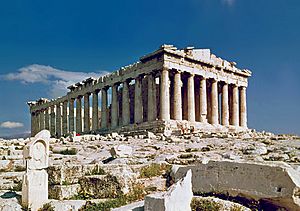
After winning a big battle in 468 BC, leaders like Cimon and Themistocles rebuilt the Acropolis walls. Most of the famous temples, including the Parthenon, were rebuilt by Pericles. This was during Athens' "Golden Age" (around 460-430 BC). Famous artists and architects like Phidias, Ictinus, and Callicrates led this huge project.
In 437 BC, Mnesicles began building the Propylaea. This was a grand gateway at the western entrance of the Acropolis. It had impressive columns made of marble. Around the same time, the small Temple of Athena Nike was started. This temple was finished later, between 421 BC and 409 BC.
The beautiful Erechtheion temple was built between 421-406 BC. It had a complex design because the ground was uneven. It also had to work around several sacred spots. One unique part of the Erechtheion is its porch supported by large female figures called caryatids. This temple honored both Athena Polias and Poseidon.
Behind the Propylaea stood a giant bronze statue of Athena Promachos. This statue, built around 450-448 BC, was 9 meters (30 feet) tall. Athena held a spear, and its golden tip could be seen by ships far away at sea.
Later Times: Hellenistic and Roman Periods
During the Hellenistic and Roman times, many Acropolis buildings were repaired. They fixed damage from age and wars. Statues of foreign kings were put up. Later, these were rededicated to Roman emperors like Augustus.
Around 161 AD, a wealthy Roman named Herodes Atticus built a large theater called an odeon on the south slope. It was destroyed later but rebuilt in the 1950s. In the 3rd century AD, new walls were built to make the Acropolis a strong fortress again.
Changes Through the Centuries
During the Byzantine period, the Parthenon became a church for the Virgin Mary. Later, when the Latins ruled Athens, the Acropolis was the city's main center. The Parthenon became a cathedral. A large tower, the Frankish Tower, was added but later removed in the 1800s.
When the Ottomans took over Greece, the Parthenon was turned into a mosque. The Erechtheion became a private home. The buildings suffered a lot of damage in 1687. This was when the Venetians attacked, and the gunpowder stored in the Parthenon exploded.
The Acropolis was attacked three times during the Greek War of Independence in the 1820s. After Greece became independent, many buildings from the Byzantine, Latin, and Ottoman periods were removed. The goal was to make the Acropolis look like it did in ancient Greek times.
In 1941, during World War II, German soldiers raised their flag over the Acropolis. But two brave Greek students, Manolis Glezos and Apostolos Santas, took it down. This was one of the first acts of resistance against the occupation.
What You Can See Today
The main entrance to the Acropolis is the grand gateway called the Propylaea. To the south of this entrance is the small Temple of Athena Nike. In the center of the Acropolis stands the famous Parthenon. East of the entrance and north of the Parthenon is the Erechtheion temple.
Below the Acropolis, you can also see the remains of the ancient Theatre of Dionysus. A bit further away is the partly rebuilt Odeon of Herodes Atticus. Many valuable ancient objects found on the Acropolis are now kept in the Acropolis Museum. This museum is located at the foot of the hill.
Map of the Acropolis Buildings
This map shows the main ancient buildings on the Acropolis.

- Parthenon
- Old Temple of Athena
- Erechtheum
- Statue of Athena Promachos
- Propylaea
- Temple of Athena Nike
- Eleusinion
- Sanctuary of Artemis Brauronia or Brauroneion
- Chalkotheke
- Pandroseion
- Arrephorion
- Altar of Athena
- Sanctuary of Zeus Polieus
- Sanctuary of Pandion
- Odeon of Herodes Atticus
- Stoa of Eumenes
- Sanctuary of Asclepius or Asclepieion
- Theatre of Dionysus Eleuthereus
- Odeon of Pericles
- Temenos of Dionysus Eleuthereus
- Mycenaean fountain
Bringing the Acropolis Back to Life: Restoration Work
Since 1975, a big project has been underway to fix the Acropolis. The goal is to repair damage from centuries of weather, pollution, wars, and even past mistakes in restoration. Workers collect and identify every stone piece, even tiny ones. They try to put original pieces back together, using new marble only when necessary.
All repairs are made so they can be undone later if experts find better ways. This project uses both modern technology and ancient building methods. For example, the Parthenon's columns, damaged in the 17th century, have been restored. Many columns that were put together incorrectly are now in their right places. The roof and floor of the Propylaea have also been partly restored. The Temple of Athena Nike was fully restored in 2010.
A huge amount of work has been done. Over 2,675 tons of architectural pieces have been restored. This includes 686 stones reassembled from original fragments. About 530 cubic meters (18,717 cubic feet) of new marble were used. In 2021, new concrete paths were added to make the site easier to access. This caused some discussion among archaeologists.
Why the Acropolis is So Important
Every four years, Athenians held a huge festival called the Great Panathenaea. It was as popular as the Olympic Games! A procession would travel through the city and end at the Acropolis. There, a new robe made of wool was placed on a statue of Athena. This was either the statue in the Erechtheion or the one in the Parthenon.
For hundreds of years, the Acropolis has been a powerful symbol. It represents the amazing history of Greece and the greatness of ancient Greek culture. Most of the ancient objects from the temples are now in the Acropolis Museum.
The Acropolis monuments are not just old buildings. They teach us about the ideas, art, and culture of the people who built them. They connect us to the past and help us understand our world today. That's why it's so important to keep them safe and help everyone, especially young people, learn about them!
The Rock Beneath: Geology of the Acropolis
The Acropolis hill is made of two main types of rock. The bottom layer is a soft, reddish rock called Athens schist. It formed about 72 million years ago. On top of that is Acropolis limestone, which is even older, about 30 million years older than the schist.
The limestone was pushed over the schist by strong forces in the Earth. Over time, erosion shaped the limestone, creating the Acropolis hill we see today. Where these two rocks meet, there are springs and caves. Other hills in Athens, like Lykabettos and Areopagus, were formed in a similar way. The marble used for the Acropolis buildings came from quarries on Mount Pentelicus, a mountain near Athens.
Keeping the Acropolis Safe: Geological Challenges
The limestone rock of the Acropolis is not always stable. Erosion and small shifts in the Earth can cause rock slides. These could damage the historic site. To protect it, engineers have built retaining walls and drainage systems. They also use rock bolts to hold the rock in place. These efforts help fight against the natural forces that threaten this amazing ancient site.
Images for kids
-
Pergamene column at the Stoa of Eumenes.
-
Temple of Asclepius.
-
North Portico of the Erechtheion, where a coffer is missing, signifying the supposed place where Zeus struck his lightning bolt, killing Erechtheus. Another belief is that this was the location where Poseidon struck his trident into the Acropolis.
-
A close-up shot of Parthenon.
See also
 In Spanish: Acrópolis de Atenas para niños
In Spanish: Acrópolis de Atenas para niños
- Landscaping of the Acropolis of Athens


